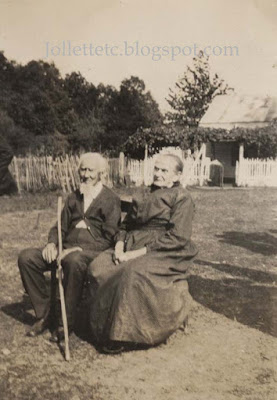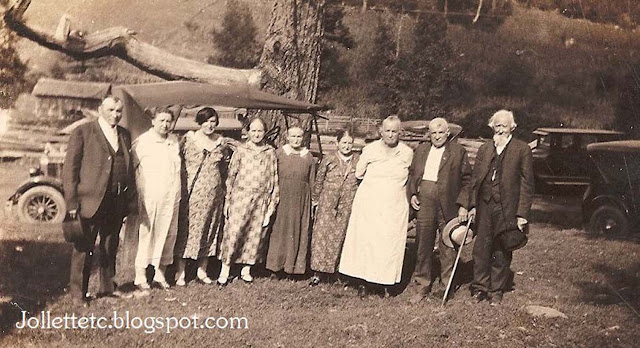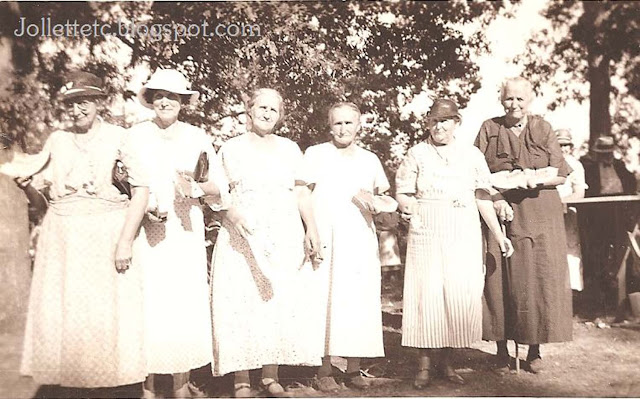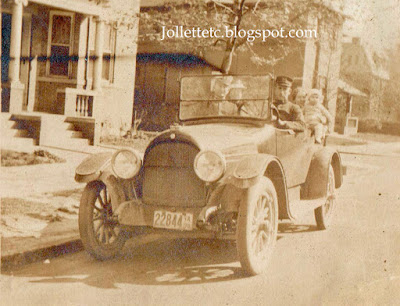Whether I am doing my own family research or tracing the
lineage of a woman applying for membership in DAR, I cannot help noticing the
names of places people were from. It seems more often than not towns were named
after people who settled there.
Here in Virginia, the names of early settlers are still
attached to communities in the Shenandoah Valley: Rileyville, Comertown, Mayland,
Cubbage Hollow, Lucas Hollow, Shiflett Hollow, Buracker Hollow, Jewell Hollow,
Hensley Hollow, Simmers Hollow, Eaton Hollow, Weaver Hollow, Wise Hollow, and –
wait for it – Jollett Hollow.
A gazetteer for Page County, Virginia contains descriptions
of the area that came to be known as “Jollett” or “Jolletts”: “
a community and
extinct post office in Shenandoah Iron Works District centered at the confluence
of the West and East Branches of Naked Creek where they form the main (North?)
branch of that creek.”
So how did the area get the name “Jollett Hollow”?
My 3X great-grandfather Fielding Jollett was the first of
the Jolletts to settle in the narrow valley that later became “Jollett Hollow.”
He married Anne Stoutemire 7 December 1822 in Rockingham County, just across
the mountain from his birthplace in Greene County. Two years later, he
purchased 2 acres that bordered land owned presumably by his in-laws.
 |
Rockingham County Deed Book B p 176
|
He amassed more land over time. In 1859 he deeded 200
acres to his son James Franklin Jollett (my 2X great-grandfather) and 37 acres
to his other son John Wesley Jollett. Both were farmers like their father. The
enterprising John Wesley also was a preacher and owner of a general store.
A book published in 1952 called A Short History of Page
County claims that there was no post office at Jollett, but records of the Post
Office Department prove otherwise. In 1888, an application was filed to locate
a post office in Shenandoah Iron Works District “7 miles east of the South Fork
of the Shenandoah River on the north bank of Naked Creek 3 miles east of
Furnace and 10 miles south of Marksville.” John Wesley Jollett applied to be
the post master and operated the post office out of his store.
 |
from US Appointments of Postmasters 1832-1971
|
The best explanation for how the community got its name
can thus be traced to the decision to locate a post office in Reverend Jollett’s
store.
Jollett’s Post Office was just one of the things bearing my
ancestors’ name. There was the Jollett School or Jollett’s Schoolhouse, the
Jollett Chapel, a Methodist Episcopal Church, and the Jollett Cemetery, all on
land provided by John Wesley Jollett.
The 1885 Lake
Atlas of Shenandoah Iron Works District
shows 2 schools near the “M E Church.” I have no explanation for that and furthermore
have no idea which one was the Jollett School. The schools are long gone but the
church and the cemetery are still in use.
 |
Jollett Methodist Church
as it looks today |
The land that John Wesley gave for the use of the church
was from a tract he purchased from his wife’s family in 1866.
The
land was once owned by Sarah Elizabeth’s great-grandfather, Revolutionary War
veteran Jacob Smith and his wife Winna (Winifred). Upon their deaths, the land
was inherited by their youngest son, Gabriel. With $100 down and a promise of 3 more cash
payments of $200 each, John Wesley purchased what appears to be connecting properties,
one about 180 acres and another about 214. The description of the property
boundary going along a “high hill” matches the lay of the land of the cemetery.
. . . the said above named parties of the first part have
this day sold & do hereby grant & convey unto the said John W. Jollett,
a certain tract or parcel of land of which Gabriel Smith died possessed, lying
& being on North Naked Creek in the County of Page & State of Virginia
& adjoining & bounded by the lands of Reuben Epard, Montella Utz, &
John Weaver, containing by estimation One hundred and eighty acres more or less
& bounded as follows to wit, Beginning at a large white pine tree, standing
on a South hill side, corner to Reuben Epard, Thence with his lines N. 2 ¾ E.
31 2/10 poles to a pile of rock near a __ tree standing near the mansion house
thence N. 21_ E. 23 6/10 poles to an oak planted thence N. 60 W. 54 [?] poles
to a black oak tree standing in a hollow near a drain, thence N. 20º E. [17?
18?] 19 poles to the gum saplings, corner to said Epard and in Montello Utz’s
line thence with his lines N. 30º E. 60 poles, to a double dogwood standing on
a hill thence N. 48 ½, E. 46 poles to a gum tree standing at the base of a hill
and near the creek, thence N. 37º E. 74 poles to the large black oak, thence S.
79 E. 166 poles to two large black oak trees, one fallen, and on the top of a
high hill, corner to __ Epard, Montello Utz, and John Weaver, thence with
Weaver’s line S. 27 ½ W. 126 poles to two blown down trees and a white oak
standing, corner to Reuben Epard, thence with his line S. 58 ½ W. 196 poles to
the beginning, containing two hundred and fourteen acres more or less.
 |
The drive up the "high hill" - steeper than it looks
(See the cemetery just above the white barn.) |
 |
Closer view of the cemetery
|
In the recent past, Jollett Hollow developed a reputation
for being a rather unsavory and unsafe place to go. Moonshine. Drugs.
Supposedly strangers could be shot for just driving by. I don’t know if any of
that is true. It seems that a bad reputation follows all places known as “the holler.”
It is still a beautiful drive and the
view from the cemetery is breathtaking. Who wouldn’t want to be buried there?
 |
Jollett Cemetery
|
The Jolletts can’t claim any great inventions or
discoveries, but they got their name on the map just the same.
Amy Johnson Crow continues to challenge genealogy
bloggers and non-bloggers alike to think about our ancestors and share a story
or photo about them. The challenge is “52 Ancestors in 52 Weeks.”
Wendy
© 2020, Wendy Mathias. All rights reserved.

















































